If Hamidiye and Mecidiye are often paired by most authors as the cornerstone of Turkish Ottoman cruiser force, later reinforced in 1914 by Midilli, ex-Breslau). Both cruisers were often compared, Mecidiye was ordered from the US, Hamidiye in UK, resulting in diverging appearance, size, tonnage, armament and capabilities. In 1901 the Ottoman Navy needed two modern protected cruisers to replace its small 1890s cruisers. She was initially ordred as Abdül Hamid, until renamed Hamidiye after the 1908 Young Turk Revolution. She took part in WWI operations, survived the Turkish War of Independence, became a TS between wars, saw WW2 and was decommissioned in 1947, not BU before 1966. But it’s 1913 and the Balkan war that her actions made headline. She became the most succesful raider in Turkish history, inspiring the German Navy later, notably during Graf Spee Campaign… #balkanwar #WW1 #hamidieh #osmanlidonmanasi #turkishnavy

Medjidieh and Hamidieh, assimilated as one class by Brasseys and many publications at the time.
Development
In 1900, the Turkish Navy was important on paper, but its real strenght was discutable, and there the Navy was confronted to two potential threats: The might of the Russian Black sea fleet and in the Balkanic waters and Aegean sea, the reconstituted Greek Navy. To face thes threats, the Navy, crippled by years of neglect and facing defeats such as the defeat at Navarino, crippling its prestige, still possessed the coast defence turret ship Hifzi Rahman, the two Avni Illah harbour defence ships (former ironclads), Fethi Bulend class (same), Idjaleh, the two Messudieh class (modenrized), Hamihieh, Abdul Kadir, while the cruise force inherited from 4 frigates, soon discarded in 1900, and the 3rd rate cruisers Heibetnuma Lufti Humayun, Shadieh and Feizi Bahri, soon discarded in 1911.
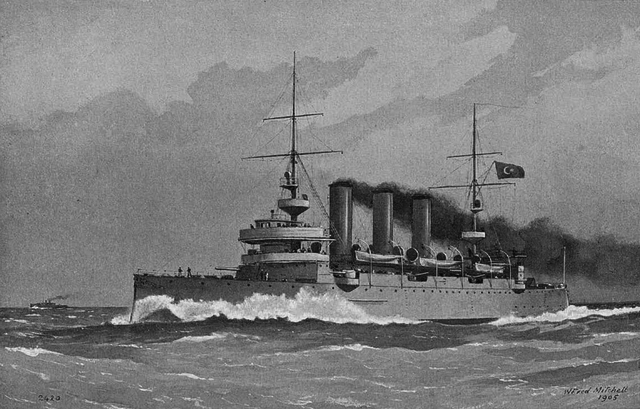
Hamidieh in Brassey’s naval annual 1905
The most palatable ship was the 4050t unprotected cruiser Hadevendighiar built in Constantinople. But she was never completed even after launch in 1892 and scrapped in 1911.
So in between the Orroman Navy needed modern fast cruisers, to adequately protect Istambul against possible Russian forays or conter the Greeks, escorting its three modernized ironclads.
Two vessels were ordered in 1901, the one in march being Abdul Hamid, to Sir W. G. Armstrong, Whitworth & Co. Ltd. of Newcastle, laid down in Yard number 732 in April 1902, so months before Medjidieh, but launched later on 25 September 1903 and finally Commissioned also later, in April 1904. She was based on the same specifications of speed and armament with a commission dispatched in Britain to survey her construction. She more or less was based on contemporary cruisers such as the Monmouth class, but less well protected and smaller, the other influence being the Highflyer/Challenger class (1898).
Design of the class
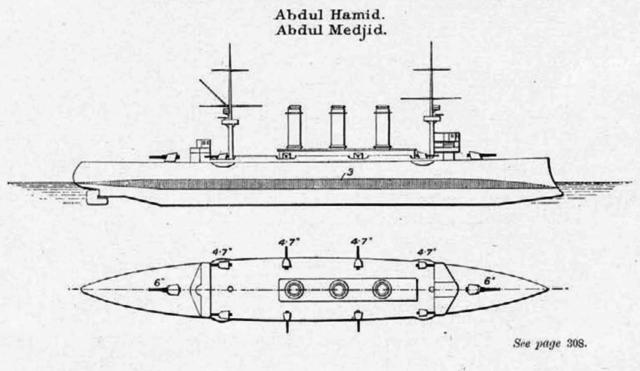
The Design was developed in Elswick as a low freeboard flush-decker, better suited to the Mediterranean. On construction, she was very close to Mecidiye, but the Turks estimated she was constructed better, with better stability, more reliable but only having nearly obsolete boilers.
Hull and general design
Hamidiye measured 112 m (367 ft) long overall and 103.6 m (340 ft) between perpendiculars, so longer than Medjidieh, and much beamier at 47 ft 6 in (14.48 m) versus 12.80 m, but less drafty at 16 ft (4.88 m). She displaced more, at 3,904 t (3,842 long tons; 4,303 short tons) at normal load versus 3,300t for Medjidieh. As for her general appearance, she was broadly similar in silhouette, with a bridge over her conning tower, flush deck but with a lower poop and higher bow, ram bow, bulwarked secondary artillery in sponsons amidships, a tall bridge over her forward conning tower, two equal size pole masts with spotting platform tops, three equally spaced funnels, shielded main guns. Both her and Medjidieh were “close sisters” but way too different to be a class. It is not clear why the Turkish admiralty chose these cruisers to two different yards. It is argued that competition between yards was perhaps used as leverage to lower the price.
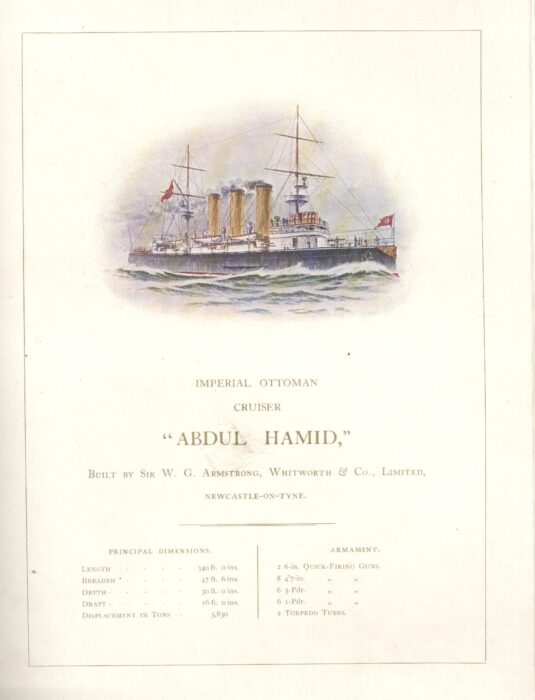
Yard’s brochure for the launch in 1903
Protection
Abdul Hamid was was protected by Krupp armor. She an internal protective deck with the horizontal portions, above the waterline amidships at the center of the turtleback was 1.5 in (3.8 cm) thick, while the side slopes extending below the waterline rose to 4 in (10 cm) thick. She also had a conning tower with likely 2-in thick walls (4.5 cm). Gun shields were lightly protected against shrapnel, likely around 0.5 inches (13 mm).
Powerplant
She was given 2-shaft VTE 4-cylinder Hawthorn Leslie vertical triple expansion engines, supplied by the steam coming from no less than sixteen Niclausse cylindrical boilers. This power plant was rated at 12,500 indicated horsepower in order to match the required contracted speed of 22 knots, and she reached on trias 22.2 knots (41.1 km/h; 25.5 mph).
However if she could 22.216kts base on 12,400 hp on a short run, in current use she was down to 20kts at 9,048 hp due to her machinery degrading fast even with acute maintenance. She was further taxed during her raring campaign of 1913 but in 1914 could made no more than 16 kts. Despite of thise she still have an active black sea campaign as well, at least until 1916.
Postwar, she rarely went at sea, being used as training ship in the interwar and even until 1947. She was modernized in 1915 and 1925 but only her armament was concerned. She needed to be reboilered and converted to oil firing, but budget was lacking.
Armament
Hamidiye was armed with medium and small caliber guns starting with her two 6 inches (15 cm)/45 Armstrong quick-firing guns, axially mounted ore and aft on deck and shielded. The second stage were eight 12 cm guns, then eight 3-pdr and six 1-pdr plus torpedo tubes.
Main: 6-in/45 Armstrong
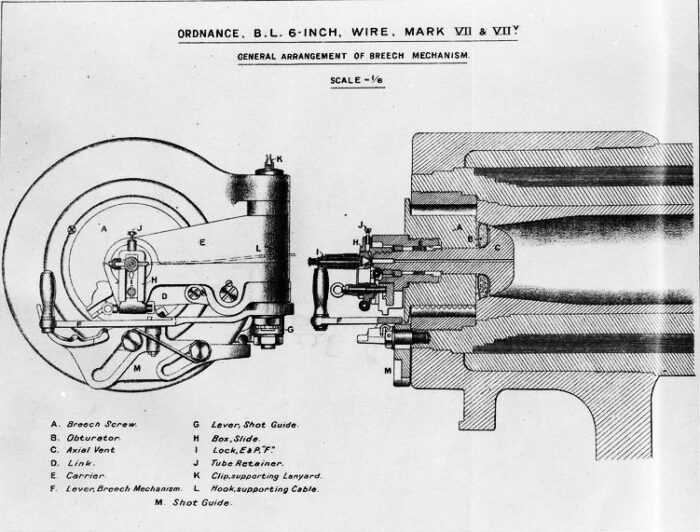
These guns fired 100 lb (45 kg) projectiles at a 5-7 rounds per minute. Their mounts enabled an elevation up to 20° for a range at that dtage of 14,600 yards (13,350 m).
Read more on navweaps
Primary complement
Eight 4.7 in (12 cm)/50 Armstrong quick-firing guns were considered as a complement primary armament, placed in four single shielded, centre-pivot mounts broadside amidships, four either side. The bulwarks on the battery deck protected against small arms fire and shrapnel.
Defensive artillery
Light artillery consisted of six 3-pounder guns (47 mm) and six 1-pounder guns (37 mm) mounted in single emplacements on the bridges fore and aft and deck.
Torpedo Tubes
Hamidiye carried two 18 in (460 mm) torpedo tubes placed in two traversing mounts underneath the forebridge.
Upgrades
After the First World War, Hamidiye was rearmed; both types of primary guns were removed, and replaced with 5.9 in (15 cm) SK L/45 and 3 in (7.6 cm) SK L/50 Krupp guns.[3]
in 1915 two 120mm/45 were removed but four 47mm/50 installed as well as four 37mm/30 guns.
In 1925-1926 she was overhauled ay Gölcük Tersane, armed with two brand new German 149/42 SK L/45 C/09 (WWI guns), and eight French 75mm/48 Canet guns as well as two 450mm torpedo tubes with 6 torpedoes in reserve and a capacity to lay 70 mines.
⚙ specifications |
|
| Displacement | 3,904 tons (normal) |
| Dimensions | 112 x 14.5 x 4.8 (367 x 48 x 16 ft) |
| Propulsion | 3 shafts, 2× VTE 4-cyl., 16× Niclausse water-tube boilers: 12,000 ihp |
| Speed | 22.2 knots, 16 kts 1914 normal |
| Range | 600t coal, 5,000 nm/10 kts |
| Armament | 2× 6-in/45, 8× 4-in/45, 6× 3-pdr/50, 6× 1pdr QF, 2× 18-in TTs, 70 mines |
| Protection | 1.5 – 4-in armored belt (30-102mm), CT, shields |
| Crew | 400 in 1904, 355 in 1915 |
The Turkish Emden
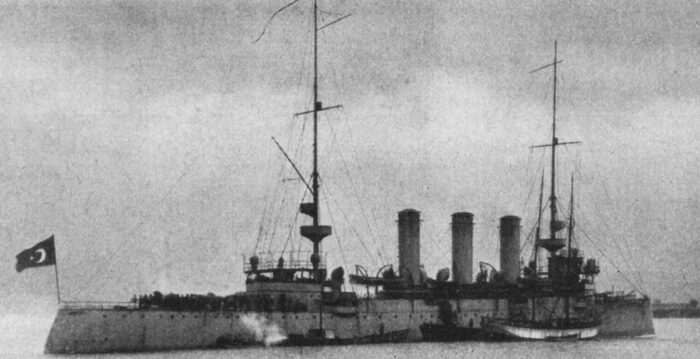
Hamidiye in 1913
The story of Hamidiye is less known that Emden, especially in the west, probably due to a general underestimation of the Turkish Ottoman Navy and army, and this despite the fiasco of the Dardanelles. If the black sea saw the impressive actions from the battlecruiser Yavuz (ex-Goeben), on cruiser in 1913 led perhaps the first and most successful raiding campaign in wartime so far. This was Hamidiye. When she stopped on 7 September at her berth in Istanbul, Captain Rauf Bey and his crew received un-ending crowd cheers. All balconies across the golden horn were decorated of navy flags, with a flotilla of small vessels as newspapers recalled his exploits. Captain Rauf Bay (or Orbay) was received in great regalia to the Palace.
In his memoirs, Rauf Bey wrote about a visit to Germany in 1914 as chief of staff of the Turkish Navy in company of Cemal Paşa (Minister of the Navy) both received by Kaiser Wilhelm and recalled:
When it was my turn, he shook my hands very warmly with both hands and said “I followed your operation closely. Our Emden tried to imitate you, however she failed. You returned to your country with glory, but they went down in the Far East.” I thanked the Kaiser for these kind words.
The cruiser’s operation was indeed judged a brilliant naval operation and it is argued the experience was not lost to the German naval admiralty indeed. This experience was indeed reproduced by lone cruisers used as merchant raiders in 1914 such as Emden.
On the Greek side, this obliged them to constantly allocate ships to various locations, unbalancing their blockading efforts. For the Turks again, this was an immense morale boost, only shining star in a rather disappointing Balkan War. However, the nexct years, albeit still active, were less brillant. The only commemorative military medal issued for the Balkan Wars was to Hamidiye, given to each of her 394 crew members.
Career of Hamidiye
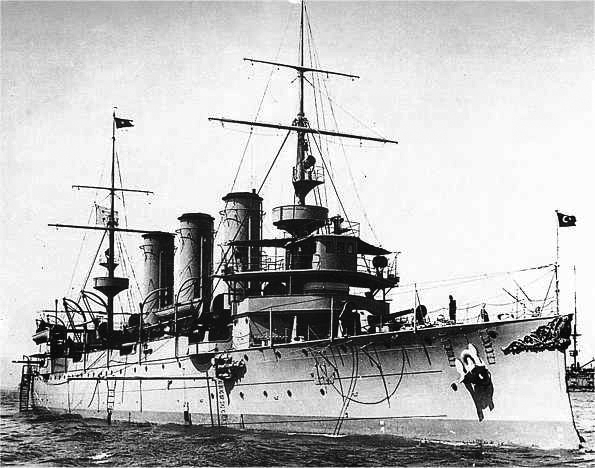
Hamidiye’s service start, after training in 1904-1907 was to hel putting down a Greek uprising at Samos (Aegean islands) in 1908. In 1909, the young Turks revolution was not a preaceful affair, and under Mahmud Şevket Pasha, she sailed to Istanbul , showing guns, used to put down the counter-revolution, the 31 March Incident). She was anchored off Yeşilköy, across from Sevket Pasha’s headquarters.
The Balkan war:
In November 1912, she shelled Bulgarian positions but was damaged in the Battle of Kaliakra by the Bulgarian torpedo boat Drazki, on hit which tore a 10 ft (3.0 m) hole in her bow, starboard side, killing 8. Her bow ended mostly submerged but she withdrawed back to port for repairs.
In the Aegean Sea:
During the Balkan Wars, it was decided that Hamidiye would selip through the Greek naval blockade of the Dardanelles, conduct a bombardment of Greek military facilities and ships in the Aegean, preventing the Greek Navy a way to used bases in the area of the Aegean and relieve the pressure on the Ottoman Navy, by drawing out the main Greek flotilla, especially the armored cruiser Georgios Averof. The plan envisaged that the ship commander, Hüseyin Rauf Bey or “Orbay”, would take an aggressive stance in the Aegean and strike facilities and ports depending on local conditions, then return to İzmir and if her way there was blocked, to secure herself in a neutral port such as Alexandria or Brindisi, being provided logistical support later.
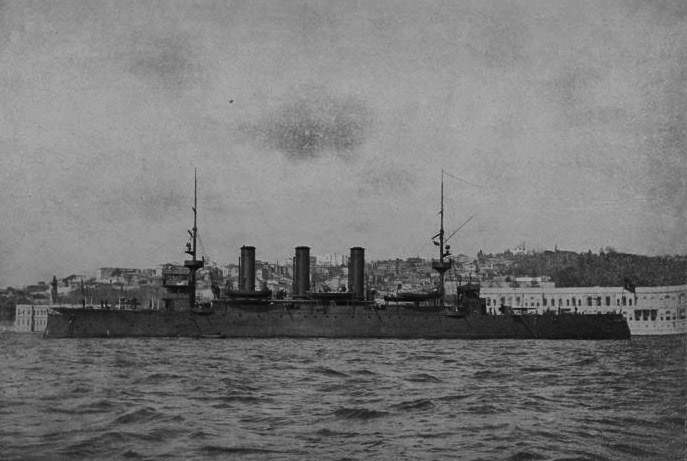
Hamidieh in 1909, note the dark green hull
After receiving an order to sail on January 13, 1913, Hamidiye left Çanakkale for the Aegean, without being detected Greek ships posted around. On January 15, 1913, she arrived in front of the Island of Syros and destroyed military targets, factory and gunpowder depot from 2800 m, then port, she disabled the Greek armed merchant cruiser “Macedonia” by gunfire. She also shelled the town of Ermoupoli. Then she moved further in the Central Aegean. During these operations Rauf Bey did not allow the personnel to wear fezzes to pass for a neutral ship belonging another country.
After the operation carried out on Sire Island, Rauf Bey decided return to the Mediterranean, considering that the Greek Navy was willing to block him with superior forces close to the Gulf of Izmir. After sailing east, giving the impression of moving towards Anatolia, the cruiser turned south in the dark and poor weather, entered the Mediterranean without being detected. She also went to Beirut and Port Said.
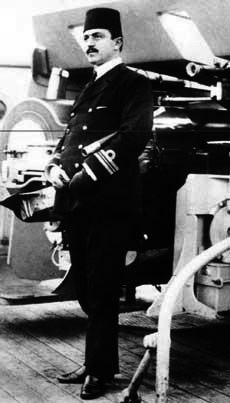 The raids of Hamidiye disrupted Greek plans indeed, avoiding pursuers and becoming bacl home a major morale booster for the new regime. The main aim to draw out forced from the blockade failed however. Georgios Averof continued her blockade, preventing a sortie of the Ottomans.
The raids of Hamidiye disrupted Greek plans indeed, avoiding pursuers and becoming bacl home a major morale booster for the new regime. The main aim to draw out forced from the blockade failed however. Georgios Averof continued her blockade, preventing a sortie of the Ottomans.
After various attempts to obtain logistic support and coal, Hamidiye arrived in Egypt, neutral on January 19, 1913. With the permission of the Khedive of Egypt, she passed the Suez Canal despite the opposition of the British Commission, and successfully completed her supply outside territorial waters, with a noria of small barges and onboard boats on January 29, 1913. After completing the supply, Orbay returned to the Mediterranean and planned to prevent reinforcements from the Western ports of Greece, another proposal of the Commander-in-Chief. According to the plan, Hamidiye was first expected to move to Malta and recoal there, then sailing close to Italian territorial waters and secretly cross to the Adriatic to launch attacks. She entered in the port of Valletta on February 14, 1913, and was authorized a stay of 24 hours according to international law, but the captain managed obtain 3 more days by alleging engine issues, managing to gather 450 tons of the 700t she needed. Orbay mastered the English language and had diplomatic skills so he developed good relations while there with British and local authorities.
She departed Malta on February 17, 1913, arrived in Gaza on February 22, 1913, anchored in Haifa on the 23th, gathered 395 tons of coal helped locally each time by Major Ömer Fevzi Mardin Bey which lanaged to obtain coal each time.
Hamidiye loaded 50 tons of ammunition and 10,000 gold coins on March 2, 1913 at Arvad Island, Syrian territorial waters and sailed to deliver them to the coerned Western Ottoman Army isolated in Albania. She departed Silifke on March 8, 1913, entered the Adriatic on March 11, 1913, undetected. He arrived close to Ialian waters in the dark, crossed to the Adriatic undetected and started operations at dawn.
On March 12, 1913, he spotted the Greek-flagged merchant “Leros” and captured her, interrogating before sending ashore the captain and 20-man crew, but to spare ammunition, she rammed the merchant. orbay later learned before this from the Greek captain he interrogated of the Greek presence, one armored ships and three destroyers in Corfu and Greek merchant ships unloading soldiers and ammunition in Şingin, Northern Albania.
*photo: Captain Rauf Bey, Erol Mütercimler collection via turkeyswar.com
She unloaded supplies for the Turkish troops in the delta of the Semeni River in Albania and immediately after, noticed the Greek destroyer Lonchi closing to 4500 meter. Assessing that he could be exposed to a sudden attack if he continued unloading, he decided to immediately head towards Şingin to attack the merchant fleet adn resupply coal.
Captain Orbay saw the port and in between, shelled Greek and Serbian positions off Albania. On 12 March 1913, Hamidiye entered the port, called on the merchant ships to surrender, unitl batteries opend fire from the hills in response, so she resumed approach, targeting first the artillery batteries, and after this, the merchant ships. There were 13 Greek merchant ships offloading Serbian troops, bound from Salonika in San Giovanni di Medua. She sank and heavily damaged six hips but also mistook a neutral Austro-Hungarian ship, as well as the Serbian military encampment. He suddenly opened range by a few kilometers when when fired upon by Serbian mountain guns from the deck of the merchant ship Trifimia.
On of these ecploded due to ammunition aboard. Poor Ottoman gunnery and limited shell stocks ended the matter though, and the the incident sparked furious complaints from the Serbs about a lack of protection of its convoys by the Hellenic Navy. At least this succeeded in having the Greeks sending stronger escort to their convoys, notably sending the ironclad Psara. Meanwhile, Hamidiye evade Greek destroyers and sailed back to Egypt. She made Another sortie south of Crete, capture another Greek merchantman. Report of Greek warships near Rhodes forced her, after her worn out boilers reduced her speed, to head for the Red Sea, and wait there until the end of the war.
He departed with just 250 tons of coal on board, sufficient to reach Alexandria and hoping not to cross the Greek Navy. He sailed close Italian territorial waters and entered the Mediterranean without being seen, reached Alexandria on March 16, 1913. After performing missions in the Eastern Mediterranean and Red Sea she managed returned to Izmir for repairs on August 26, 1913. She then left for Çanakkale on September 5, 1913, entering the Golden Horn on September 8, 1913 to a heros’s welcome.
The first world war
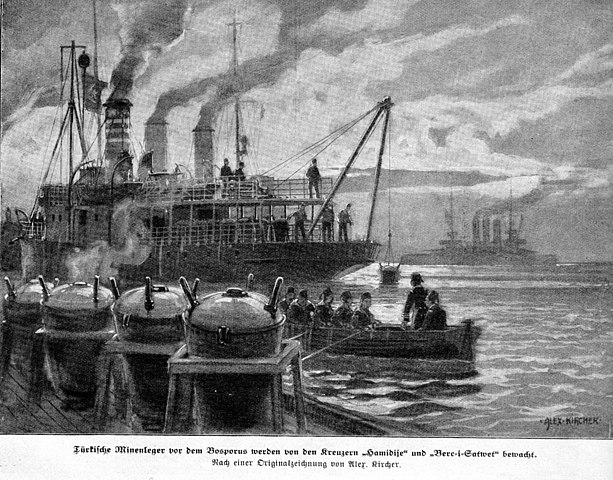
In the Bosphorus, 1915 with Berk I Savket.
During World War I, Hamidiye stayed in the Black sea, prepare for any attack from the Russian Black Sea fleet. She joined the newly acquired battlecruiser Yavûz and Midilli to guard Turkish Sea lanes and ports. She was engaged in several naval actions and was hit many times. On 23 September 1914 she esocterd transport to Trebizond. In November she shelled Russian military installations at Tuapse. She sortied in January 1915 with Midilli and on 9 January both encountered the Russian fleet off Yalta. There was a brief engagement in which Midilli hit Evstafi. They were chased all the way back but escaped. The recently repaired Yavûz steamed out of the Bosporus to cover them when they arrived, Hamidiye and Midilli, driving off the pursuing Russians.
After this, the lack of supplied had her mostly inactive in 1917.
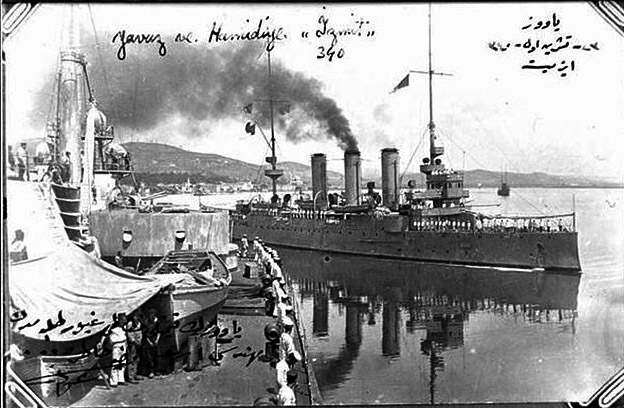
Hamidieh seen from Yavuz in 1924.
Postwar
The war ended with the signing of the Treaty of Sèvres on 10 August 1920. Hamidiye, Yavûz and remaining warships were to be ceded to Great Britain as war reparations but Turkish War of Independence under Mustafa Kemal Atatürk led to create a new Turkish state with the new Treaty of Lausanne drafted and signed in replacement. Under its terms, Kemal obtained to basically keep his fleet.
The rest of her career is not well known. It seems she saw little service, and was modernized as second time. Indeed on 30 Ovtober 1918 she was laid up, and in 1925-1926 had an extensive overhaul, and modernization at Gölcük. In 1930 Vickers-Armstrong proposed at the demand of the Turkish Naval Ministry, two variants for a deeper modernization and notably the much needed conversion of her boilers to oil-firing, speed expected up to 26kts, possible new clipper bow replacing her ram, full modernization of her artillery with modern fire control ans AA guns, but financial reasons prevented this. On 23 October 1937, she collied with Ordu at Beşiktaş, the latter sank.
Hamidiye was decommissioned in March 1947, training cadets since 1940. Between 1949 and 1951 she became a a museum ship at the Kabataş quarter in Istanbul, European shoreline. Hoever budget was lacking to keep her maintained and she was laid up at the Golden Horn between 1951 and 1964, degraded until sold for scrap on 10 September 1964, towed to the Paşabahçe quarter, Beykoz district of Istanbul (Anatolian shoreline) and BU until 1966.
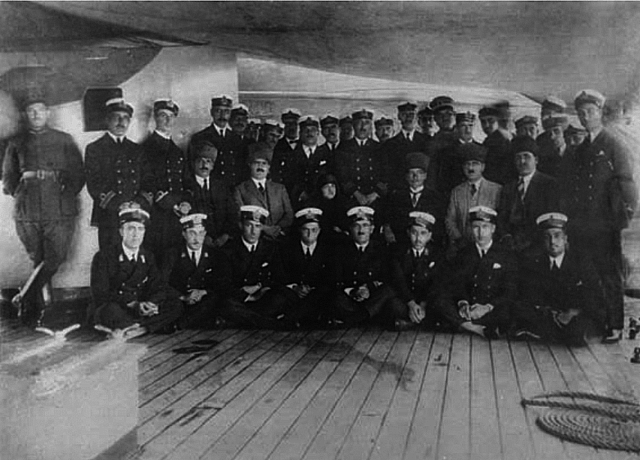
Kemal Atatük posing with Hamidieh’s officers in Samsun, 1924
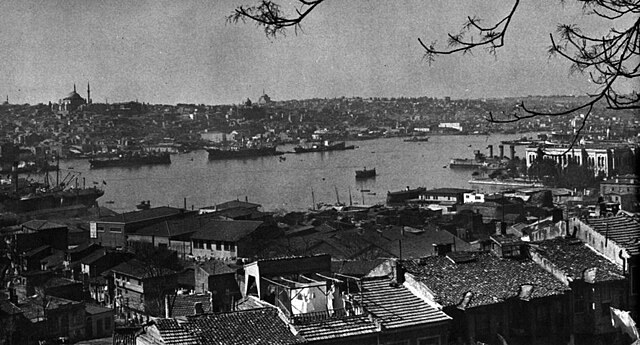
View of the Golden Horn near Istanbul, 1955. Hamidiye can be seen laid up at the right.
Read More/Src
Books
The Ottoman Steam Navy, 1828-1923 Bernd Langensiepen, Ahmet Güleryüz
Links
http://www.navypedia.org/ships/turkey/tu_cr_hamidiye.htm
https://web.archive.org/web/20091215154745/http://www.turkishmedals.net/campmedals.htm
https://web.archive.org/web/20100225123714/http://www.turkeyswar.com/navy/battleships-hamidiye.htm
http://www.navweaps.com/Weapons/WNBR_6-45_mk7.php
https://en.wikipedia.org/wiki/Ottoman_cruiser_Hamidiye
https://tr.wikipedia.org/wiki/Hamidiye_(kruvaz%C3%B6r)

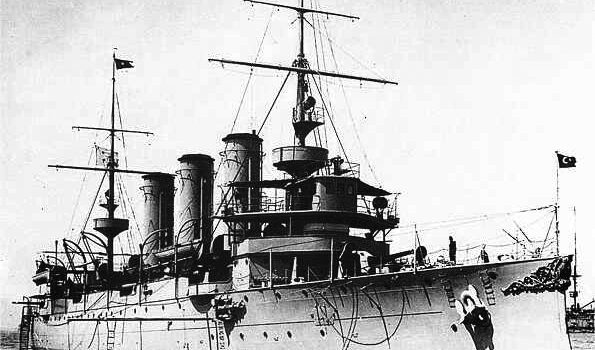

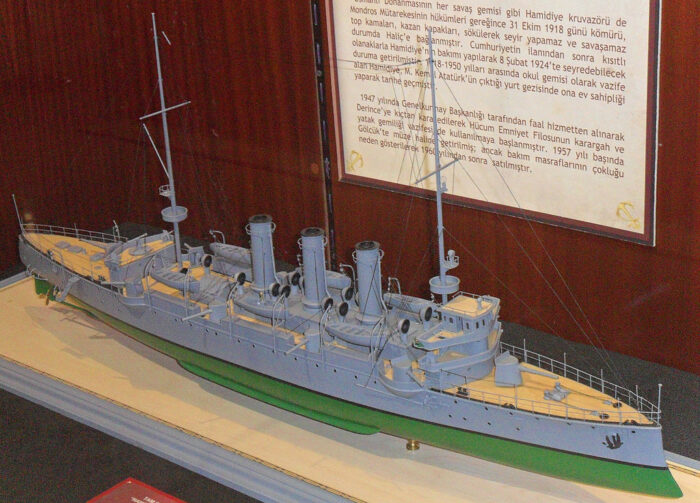
 Latest Facebook Entry -
Latest Facebook Entry -  X(Tweeter) Naval Encyclopedia's deck archive
X(Tweeter) Naval Encyclopedia's deck archive Instagram (@navalencyc)
Instagram (@navalencyc)





 French Navy
French Navy Royal Navy
Royal Navy Russian Navy
Russian Navy Armada Espanola
Armada Espanola Austrian Navy
Austrian Navy K.u.K. Kriegsmarine
K.u.K. Kriegsmarine Dansk Marine
Dansk Marine Nautiko Hellenon
Nautiko Hellenon Koninklije Marine 1870
Koninklije Marine 1870 Marinha do Brasil
Marinha do Brasil Osmanlı Donanması
Osmanlı Donanması Marina Do Peru
Marina Do Peru Marinha do Portugal
Marinha do Portugal Regia Marina 1870
Regia Marina 1870 Nihhon Kaigun 1870
Nihhon Kaigun 1870 Preußische Marine 1870
Preußische Marine 1870 Russkiy Flot 1870
Russkiy Flot 1870 Svenska marinen
Svenska marinen Søværnet
Søværnet Union Navy
Union Navy Confederate Navy
Confederate Navy Armada de Argentina
Armada de Argentina Imperial Chinese Navy
Imperial Chinese Navy Marinha do Portugal
Marinha do Portugal Mexico
Mexico Kaiserliche Marine
Kaiserliche Marine 1898 US Navy
1898 US Navy Sovietskiy Flot
Sovietskiy Flot Royal Canadian Navy
Royal Canadian Navy Royal Australian Navy
Royal Australian Navy RNZN Fleet
RNZN Fleet Chinese Navy 1937
Chinese Navy 1937 Kriegsmarine
Kriegsmarine Chilean Navy
Chilean Navy Danish Navy
Danish Navy Finnish Navy
Finnish Navy Hellenic Navy
Hellenic Navy Polish Navy
Polish Navy Romanian Navy
Romanian Navy Turkish Navy
Turkish Navy Royal Yugoslav Navy
Royal Yugoslav Navy Royal Thai Navy
Royal Thai Navy Minor Navies
Minor Navies Albania
Albania Austria
Austria Belgium
Belgium Columbia
Columbia Costa Rica
Costa Rica Cuba
Cuba Czechoslovakia
Czechoslovakia Dominican Republic
Dominican Republic Haiti
Haiti Hungary
Hungary Honduras
Honduras Estonia
Estonia Iceland
Iceland Eire
Eire Equador
Equador Iran
Iran Iraq
Iraq Latvia
Latvia Liberia
Liberia Lithuania
Lithuania Mandchukuo
Mandchukuo Morocco
Morocco Nicaragua
Nicaragua Persia
Persia San Salvador
San Salvador Sarawak
Sarawak Uruguay
Uruguay Venezuela
Venezuela Zanzibar
Zanzibar Warsaw Pact Navies
Warsaw Pact Navies Bulgaria
Bulgaria Hungary
Hungary

 Bundesmarine
Bundesmarine Dutch Navy
Dutch Navy Hellenic Navy
Hellenic Navy Marina Militare
Marina Militare Yugoslav Navy
Yugoslav Navy Chinese Navy
Chinese Navy Indian Navy
Indian Navy Indonesian Navy
Indonesian Navy JMSDF
JMSDF North Korean Navy
North Korean Navy Pakistani Navy
Pakistani Navy Philippines Navy
Philippines Navy ROKN
ROKN Rep. of Singapore Navy
Rep. of Singapore Navy Taiwanese Navy
Taiwanese Navy IDF Navy
IDF Navy Saudi Navy
Saudi Navy Royal New Zealand Navy
Royal New Zealand Navy Egyptian Navy
Egyptian Navy South African Navy
South African Navy






























 Ukrainian Navy
Ukrainian Navy dbodesign
dbodesign